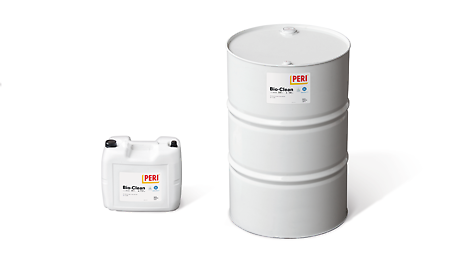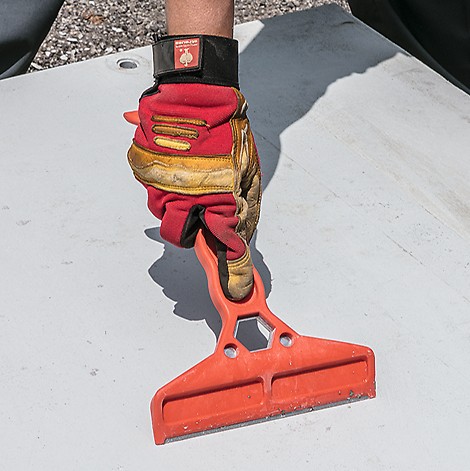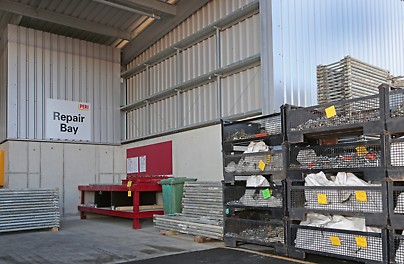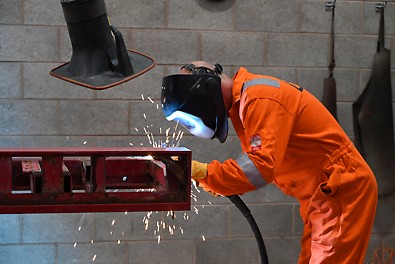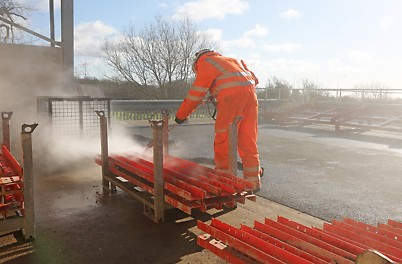
Get in touch
Contact us to discuss cleaning, repair or refurbishment of your PERI equipment, or purchase the cleaning products we have covered in this guide.
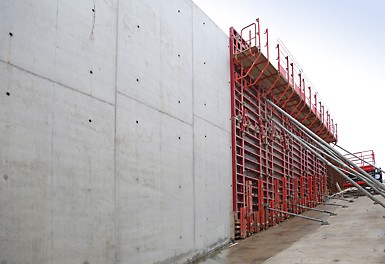
Due to the high demands placed on formwork material, it is essential that regular maintenance must be undertaken to ensure the product continues to perform as expected.
Whilst we offer professional cleaning and repair services for most PERI products, there are steps that you can take to perform preventive maintenance that will significantly increase their lifespan.
Applying concrete release agents to all equipment prior to use on site will ensure any overspill of concrete can be easily removed from the formwork. For metal formwork elements, we recommend using PERI Bio Clean, which is a semi-synthetic, solvent-free release agent that does not discolour concrete surfaces.
For our polymer-based products such as DUO, we recommend using PERI Plasto Clean. It’s a hydrophilic, mineral oil-based, solvent-free, non-water miscible release agent that not only helps extend product life but reduces porosity and cavity formation.
Due to the hydrophilic properties, the surface tension is reduced and the release agent is very easily absorbed into the formlining thus achieving an excellent level of wetting. It also prevents rusting of construction equipment, while helping ensure prop and spindle threads run smoothly.
We recognise how hard the equipment we sell has to work. We know it’s durability and performance are unrivalled, allowing it to be used almost continuously, but you should make time for cleaning and inspection to extend the serviceable life of your formwork products.
With the appropriate release agent applied to the equipment prior to use, you will find it easier to jet wash the concrete off before it has had time to fully cure. Once the concrete has cured, it not only makes cleaning more difficult, but over time it can affect the powder coated surfaces.
When you come across spills that have hardened, these should be removed with a scraper or chipped off carefully, whilst wearing the appropriate eye protection.
Like a lot of hardware on the construction site, cleaning comes down to diligent use of a pressure washer and hand tools to remove stubborn hardened concrete. However, once the product is clean, the next and perhaps most important stage is the visual inspection.
Transporting equipment onto site and into position, as well as its use, can sometimes lead to damage. Some damage may only appear cosmetic, with chipped or missing powder coating affecting the look of the product, but it allows water and concrete to attack the steel, introducing the risk of rust damage.
You should pay special attention to tie points and function holes when inspecting your formwork, all of which will need to be freed of all concrete residue. The formlining also needs careful inspection to ensure optimal future performance, with damaged panels earmarked for replacement – a job our cleaning and repair teams can support you with. You can find out more about our cleaning and repair services below.
Once you have cleaned, inspected and assessed whether your formwork needs repairing or replacing, you will need to store your equipment correctly to keep it in good condition until the next time it’s needed.
When it’s not in use, a light oiling of all the equipment before it is stored will go a long way to protecting it and this is where we would again recommend the use of PERI Clean, our release agent based on mineral oil, which prevents rusting of construction equipment and machinery.
Formwork panels and other equipment should be stacked with spacers to ensure the weight is more evenly distributed. If in doubt about the best way to store the equipment you have purchased, please get in touch and we can provide further guidance.
Our timber girders, which are made from slow-grown sustainable Nordic pine have been pressure treated and coated to improve durability. These simply need to be washed off and checked for cuts, cracks and serious damage before storage.
Once you’re happy with the cleaning and inspection, it’s then ready to be stacked for storage. When storing your timber girders, you should ensure adequate air flow around them, to ensure they maintain their optimal service life.
This guide is based on our knowledge and experience of handling the hire and return of formwork and falsework for over 50 years.
We’ve shared the tools to use and actions you can take to maximise the lifespan of your equipment.
If you’d prefer a deeper clean or if your repair looks more complicated, we can take this off your hands as part of our cleaning and repair services.
If you have a large inventory of formwork and falsework equipment purchased from PERI, it may be worth doing a quick audit to assess the condition and understand if it needs to be returned for servicing at one of our depots.
We use professional and purpose-built machinery in our depots, so we can support you with minor or major cleaning and repair requirements.
Once your equipment arrives at our depot, we will clean it first so that we can assess the extent of the repair. In the case of formwork panels, we will inspect every weld for cracking or signs of stress, and examine the frames for cracks, holes, and distortions.
We can also apply a new powder coating, so your equipment looks as good as new before returning it back to you fully refurbished and ready for years of use.
If we feel your equipment is beyond the scope of repair, we will notify you of this and discuss the options with you.
Contact us to discuss cleaning, repair or refurbishment of your PERI equipment, or purchase the cleaning products we have covered in this guide.
